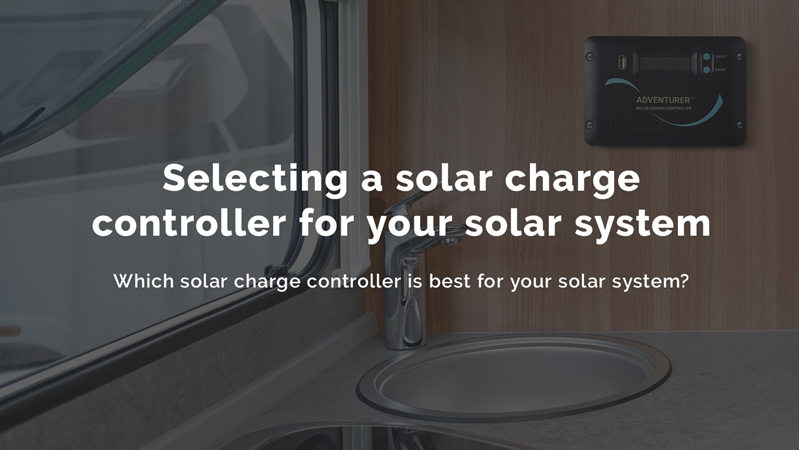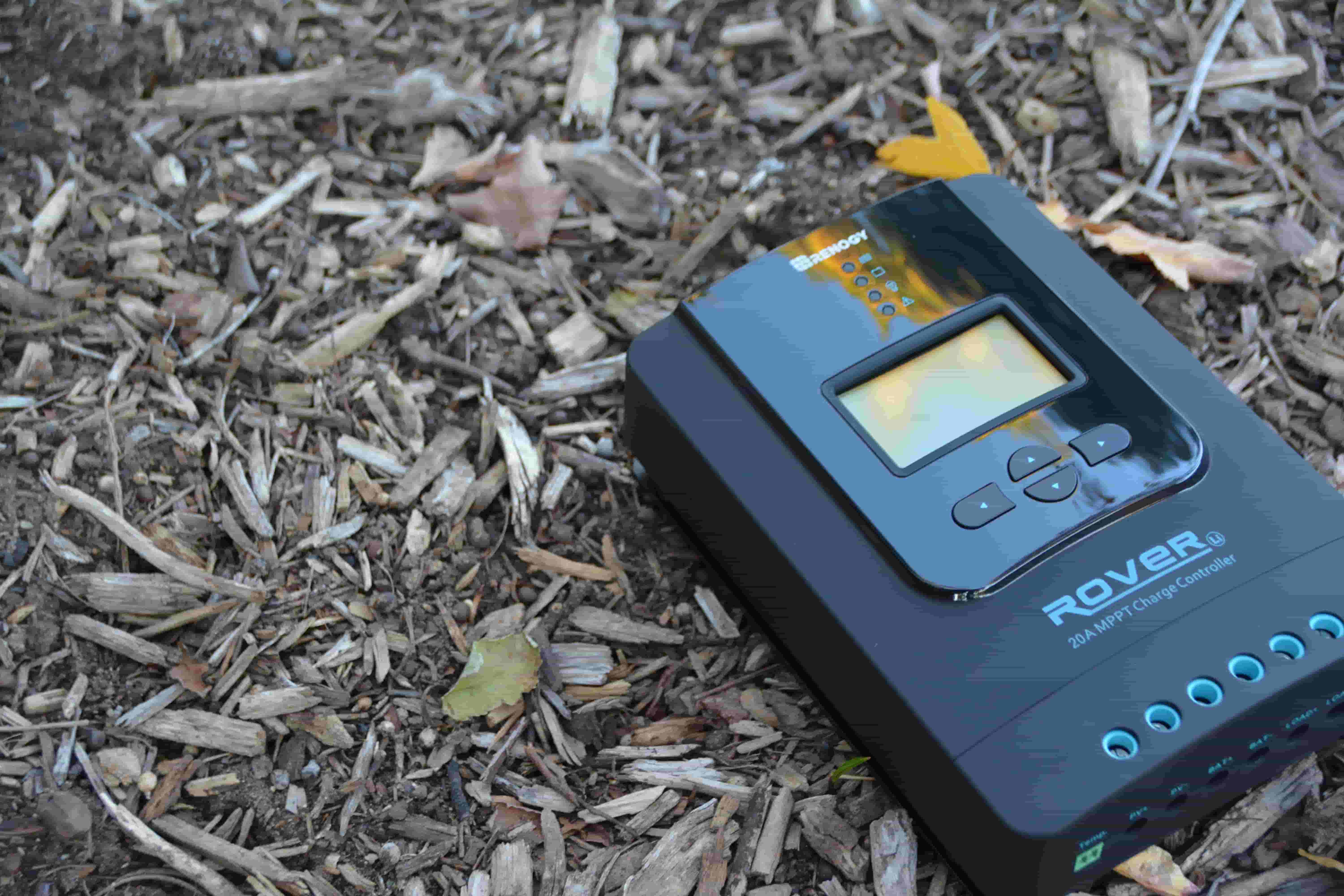What is the difference between MPPT and PWM charge controllers?
There are two different methods used by the controller to regulate the power from the solar panel to charge the battery.
- MPPT (Maximum Power Point Tracking)
- PWM (Pulse Width Modulation)
MPPT charge controllers means that they can continuously track the maximum power point of the solar panel array to ensure maximum power output under varying conditions like shading, temperature changes, and panel degradation. The PWM controller regulates the charging current by rapidly switching the connection between the solar panel and the battery bank, maintaining the battery voltage at a constant level.
PWM charge controllers are an older technology and are cheaper, but less efficient than MPPT charge controllers. Both are widely used and perform similar functions of preserving the life of your batteries. Also, it’s important to point out that it’s not a matter of which is best all-around, but often what is best for your unique case. Also, we highly recommend purchasing a high quality charge controller since controllers only account for a small portion of the total system cost. Both pulse width modulation and maximum power point tracking charge controllers have a lifespan of about 15 years, although that will vary based on the specific controller.

What is PWM Charge Controllers
The pulse width modulation controller was the original charge controller used and are simpler and less expensive than MPPT controllers. PWM controllers regulate the flow of energy to the battery by reducing the current gradually, called "pulse width modulation". When batteries are full, PWM charge controllers continue to supply a tiny amount of power to keep batteries full. PWM controllers are best for small scale applications because the solar panel system and batteries have to have matching voltages. This becomes a much more difficult with larger installations.
Cost: $20-$60
Pros of PWM charge Controllers
- Cheaper than MPPT controllers
- Best for smaller systems where the efficiency is not as critical
- Typically longer lifespan due to less components that may break
- Best for warm sunny weather
- Performs best when the battery is near the full state of charge
Cons of of PWM charge Controllers
- Less Efficient than MPPT controllers
- Because solar panels and batteries have to have matching voltages with these controllers, they are not ideal for larger, complex systems
Best for: Those with smaller systems (vans, RVs, tiny homes), those living in warmer climates

What is MPPT Charge Controllers
Maximum Power Point Tracking controllers are efficient at using the full power of your solar panels to charge your batteries. They limit their output to ensure batteries don’t get overcharged. MPPT controllers will monitor and adjust their input to regulate your solar system’s current. MPPT controllers step down the voltage and boost the current. The overall output will increase as a result and you can expect efficiency ratings of 90% or higher. MPPT charge controllers are more common nowadays
For example, if it becomes cloudy, your MPPT charge controller will decrease the amount of current drawn in order to maintain a desirable voltage at the output of the panel. When it becomes sunny again, the MPPT controller will allow more current from the solar panel once again.
Cost: $100-$729
Pros of MPPT charge Controllers
- Highly efficient
- Best for larger systems where the additional energy production is valuable
- Ideal for situations where the solar array voltage is higher than the battery voltage
- Best in colder, cloudier environments
- Performs best when the battery is in a low state of charge
Cons of MPPT charge Controllers
- More expensive than MPPT controllers
- Typically shorter lifespan due to more components
Best for: Those with larger systems (cabins, homes, cottages), those living in colder climates
What is the Difference between MPPT and PWM Charge Controller
Here are some main key differences between MPPT and PWM Solar Charge Controller:
Efficiency
MPPT controllers are more efficient than PWM controllers, particularly in varying weather conditions. They ensure that the solar panels operate at their maximum power point, which translates into more energy being harvested and stored.
Complexity and Cost
PWM controllers are simpler and less costly, making them suitable for small-scale and budget-conscious applications. MPPT controllers, on the other hand, justify their higher cost with improved performance and energy efficiency, ideal for larger or more demanding systems.
Performance in Different Conditions
MPPT controllers outperform PWM controllers in cold temperatures and low-light conditions. They are adept at adjusting to fluctuating environmental conditions, whereas PWM controllers tend to be less flexible.
Application Suitability
PWM controllers are often sufficient for small, simple solar setups, such as basic residential systems or small off-grid applications. MPPT controllers, due to their higher efficiency and versatility, are better suited for larger systems, including commercial installations and complex off-grid systems.

How to size your charge controller (mppt vs pwm)
Overall, charge controller sizing is not as difficult as you may think. Charge controllers are rated and sized depending on your solar array's current and the solar system’s voltage. You typically want to make sure you have a charge controller that is large enough to handle the amount of power and current produced by your panels.
Typically, charge controllers come in 12, 24 and 48 volts. Amperage ratings can be between one and 60 amps and voltage ratings from six to 60 volts.
If your solar system's volts were 12 and your amps were 14, you would need a solar charge controller that had at least 14 amps. However due to factors such as light reflection, sporadic increased current levels can occur, you need to factor in an additional 25% bringing the minimum amps that our solar charger controller must have to 17.5 amps. We’ll round up in this case, so in the end, you would need a 12 volt, 20 amp solar charge controller.
When it comes to charge controller sizing, you also have to take into consideration whether you’re using a PWM or MPPT controller. An improperly selected charge controller can result in up to a 50% loss of the solar generated power.
What to consider with MPPT charge controllers: Because MPPT controllers limit their output, you can make an array as large as you want and a controller will limit that output. However, this means your system isn’t as efficient as it could be since you have panels that aren’t being properly utilized. MPPT controllers will have an amp reading for it, for example a 40 Amp MPPT Controller. Even if your panels have the potential to produce 80A of current, an MPPT charge controller will only produce 40A of current, no matter what.
What to consider with PWM charge controllers: PWM controllers are unable to limit their current output. They simply use the array current. Therefore, if the solar array can produce 40A of current and the charge controller you’re using is only rated to 30A, then the controller could be damaged. It’s crucial to ensure your charge controller is matched, compatible with, and properly sized for your panels.
What is the upper voltage limit?
All solar charge controllers have an upper voltage limit. This refers to the maximum amount of voltage the controllers can safely handle. Make sure you know what the upper voltage limit of your controllers is. Otherwise you may end up burning out your solar charge controller or creating other safety risks.
How to Choose the Right Solar Charge Controller
The following factors should be considered when buying a charge controller:
- Your budget
- Lifespan of the technology
- Climate where your system will be installed
- How many solar panels you have and how high your energy needs are
- Size, number, and type of batteries you’re using in your system

Common Charge Controller Mistakes and Errors
Because of all the different components of a solar installation, it can be easy to make a misstep in the installation process. Here are a few commonly made mistakes when it comes to solar charge controllers.
- Do not connect AC loads to the charge controller. Only DC loads should be connected to the charge controller’s output.
- Certain low-voltage appliances must be connected directly to the battery.
- The charge controller should always be mounted close to the battery since precise measurement of the battery voltage is an important part of the functions of a solar charge controller.
Conclusion
Both MPPT and PWM solar charge controllers have their advantages and considerations. MPPT controllers offer higher efficiency, faster charging times, and increased energy harvest, making them suitable for larger solar systems. PWM controllers provide a cost-effective and reliable solution for smaller systems. By understanding the differences and evaluating your system requirements, you can make an informed choice.








